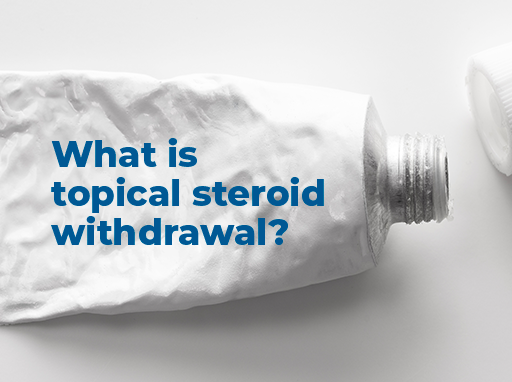
About this publication
This publication aims to review what patients are describing related to topical corticosteroids and eczema. We hope the content shared here will make it easier for patients and healthcare providers to discuss treatments and the management of eczema. This publication was drafted in May 2024 after a review of the current literature on the subject, including the references below. This content was up to date at the time of publication, and new information will likely emerge after this publication, which will help the community better understand this phenomenon.
About topical corticosteroids
Topical corticosteroids (TCS) have been a mainstay of treatment for eczema for decades and remain listed as a mainstay treatment in recent guidelines developed in the United States, Europe and Japan.1,2 Topical corticosteroids were first used in the early 1950s and are used around the world for the management of eczema and atopic dermatitis, in addition to other conditions. Like all medications, there is the possibility of side effects, and these have been known for decades. According to guidelines for the management of atopic dermatitis, corticosteroids remain a safe and effective treatment to manage eczema flares. 1, 2, 3 The side effects of topical corticosteroids are well known, such as skin thinning and stretch marks. Topical corticosteroids range in strength from very mild to very potent.
What is topical steroid withdrawal?
In recent years, there has been increasing social media attention on what has become known as Topical Steroid Withdrawal (TSW), Topical Steroid Addiction, or Red Skin Syndrome. The acronym TSW is commonly used. TSW is a phenomenon that patients report experiencing after using topical corticosteroids.
While there is still a lot that is unknown about this phenomenon, and more research is needed to better understand these reports from patients, sufferers are describing bothersome symptoms after stopping the prolonged use of TCS. Researchers are looking into TSW and working to better understand this phenomenon. This is complex as the symptoms of TSW can be like the symptoms of an eczema flare, and the symptoms of TSW on the face may appear similar to other dermatologic conditions, such as rosacea or perioral dermatitis.
In 2015, a group of dermatologists and researchers conducted an in-depth review of this subject and published an article in the Journal of the American Academy of Dermatologists.4 Their review concluded that topical corticosteroids remain an important therapy for inflammation of the skin and eczema and recommended that “TCS withdrawal (is) an adverse effect that generally occurs with the inappropriate prolonged and frequent use of high-potency TCS. Patients should be counselled regarding the risks, including TCS withdrawal, from prolonged daily use of TCS beyond their approved indication.”
ESC spoke with Dr. Peter Lio, a Chicago-based dermatologist and professor, ESC medical contributor, and author of several scientific papers on TSW. He shared, “Patients are reporting symptoms of TSW typically after the prolonged use of potent or super potent topical corticosteroids. We don’t have accepted diagnostic criteria for TSW at this time, but we know that patients are reporting these symptoms. The good news is there are many other treatment options for eczema that aren’t from the corticosteroid class or family of medications.”
A 2022 article published in the Journal of Dermatologic Treatment indicated that the phenomenon referred to as “topical corticosteroid withdrawal” typically occurs after prolonged use of moderate to high-intensity topical corticosteroids on the face.4 It was also noted that this phenomenon is more common in women, and symptoms reported by sufferers include redness, itchiness, and burning. TSW also seems to be more commonly seen with prolonged use of daily TCS or TCS used on more sensitive areas of the body without periodic breaks. While this systematic review of evidence did outline some clinical characteristics of TSW, the quality of evidence was low, and criteria for defining TSW are missing.
What other conditions can be mistaken for TSW?
TSW gets a lot of attention on social media, but it affects only a small proportion of patients seen by dermatologists.6 Sometimes, patients who think they may have TSW have a different condition, and the good news is that with appropriate treatment, those other conditions can be resolved. This is why being seen by a specialist can be important. Some of the common ones are:
- Eczema flares – Sometimes, what patients describe is a flare of the condition itself, which responds to treatment. Eczema flares can be treated effectively with topical corticosteroids, without experiencing side effects. If the eczema returns after a period of time, that could be the condition itself and not necessarily a sign of TSW.
- Rosacea or perioral dermatitis – Some patients may develop rosacea or perioral dermatitis, inflammatory skin conditions that often affect the face. There are treatments to manage and improve these conditions, and topical corticosteroids are not a treatment for these conditions and can, in fact, make them both worse. Antibiotics are commonly used to treat these conditions.
- Skin infections – Infections of the skin are common with eczema, and certain bacterial, fungal, or viral infections can look like and can be mistaken for TSW.
- Allergy to topical corticosteroids or an ingredient in the vehicle – Patients can be allergic to topical corticosteroids or to an ingredient in the vehicle (the vehicle is the cream or ointment that the medicine is mixed into so that it can be applied to the skin).
- Contact dermatitis – Sometimes, this condition can cause symptoms on the face or other parts of the body that are similar to what is described in the early literature on TSW.
With all of these conditions listed above, a qualified healthcare professional, such as a dermatologist, can help to better understand what patients are experiencing, provide an accurate diagnosis, and make recommendations to manage the condition.
Why is TSW so difficult to discuss?
- The lack of a clear medical definition and agreement as to what TSW is makes it difficult for patients and health care professional to discuss the phenomenon.
- There is a lot of information and misinformation on social media and the internet about TSW.
- There are other conditions that are confused for TSW.
- At this time of this article, there is very little research about TSW.
What can be done?
Research – More research is needed to better understand TSW.
Healthcare professional counselling – Healthcare professionals should counsel patients on how to use topical corticosteroids, including providing information on how potent the medicine is, how and where to apply it, and how long it can be used.
Patients should seek qualified healthcare professionals – Patients should work with their qualified healthcare professional to manage their eczema and should report any side effects right away.
Adverse events should be reported – Patients can report any concerns related to treatment to the prescribing health care provider, and adverse events with topical corticosteroids or any medication can be reported to Health Canada.7
Eczema can be treated with topical corticosteroids – The good news is that in 2024 there are many non-steroidal options, meaning topical treatments that don’t contain any steroids, and these can help patients manage their eczema. A qualified health care professional can help patients manage their eczema taking patient experiences, concerns, and preferences into account when prescribing medications.
Summary
More research is needed to better understand TSW – including what it is and how it differs from the symptoms of eczema and other skin conditions. While the internet is full of quality information, it is also full of misinformation. Therefore, ESC encourages eczema patients and caregivers to work with their qualified health care provider to optimize their management plan and address any treatment concerns. Any immediate medical concerns or worsening of symptoms should be report to their healthcare provider immediately. The good news for treating eczema today is that there are many nonsteroidal options to treat the condition.
Eczema Society of Canada (ESC) thanks Peter Lio, MD, FAAD, for his volunteer contribution to this educational content.
References:
- National Eczema Association, Appropriate use of topical corticosteroids. Available at: https://nationaleczema.org/appropriate-use-of-topical-corticosteroids/ (Accessed: 2 May 2024)
- Sidbury R, Alikhan A, Bercovitch L, Cohen DE, Darr JM, Drucker AM, Eichenfield LF, Frazer-Green L, Paller AS, Schwarzenberger K, Silverberg JI, Singh AM, Wu PA, Davis DMR. Guidelines of care for the management of atopic dermatitis in adults with topical therapies. J Am Acad Dermatol. 2023 Jul;89(1):e1-e20. doi: 10.1016/j.jaad.2022.12.029. Epub 2023 Jan 12. PMID: 36641009.
- AAAAI/ACAAI JTF Atopic Dermatitis Guideline Panel; Chu DK, Schneider L, Asiniwasis RN, Boguniewicz M, De Benedetto A, Ellison K, Frazier WT, Greenhawt M, Huynh J, Kim E, LeBovidge J, Lind ML, Lio P, Martin SA, O’Brien M, Ong PY, Silverberg JI, Spergel JM, Wang J, Wheeler KE, Guyatt GH; Patient Groups: Global Parents for Eczema Research; Capozza K; National Eczema Association; Begolka WS; Evidence in Allergy Group; Chu AWL, Zhao IX, Chen L, Oykhman P, Bakaa L; AAAAI/ACAAI Joint Task Force on Practice Parameters; Golden D, Shaker M, Bernstein JA, Greenhawt M, Horner CC, Lieberman J, Stukus D, Rank MA, Wang J, Ellis A, Abrams E, Ledford D, Chu DK. Atopic dermatitis (eczema) guidelines: 2023 American Academy of Allergy, Asthma and Immunology/American College of Allergy, Asthma and Immunology Joint Task Force on Practice Parameters GRADE- and Institute of Medicine-based recommendations. Ann Allergy Asthma Immunol. 2024 Mar;132(3):274-312. doi: 10.1016/j.anai.2023.11.009. Epub 2023 Dec 18. PMID: 38108679.
- Hajar, T., Leshem, Y.A., Hanifin, J.M., Nedorost, S.T., Lio, P.A., Paller, A.S., Block, J., Simpson, E.L., (2015) A systematic review of topical corticosteroid withdrawal (“steroid addiction”) in patients with atopic dermatitis and other dermatoses, Journal of the American Academy of Dermatology, 72:3, 541-549, https://www.jaad.org/article/S0190-9622(14)02209-9/abstract
- Hwang, J., & Lio, P.A., (2022) Topical corticosteroid withdrawal (‘steroid addiction’): an update of a systematic review, Journal of Dermatological Treatment, 33:3, 1293-1298, DOI: 10.1080/09546634.2021.1882659
- National Eczema Society, British Dermatological Nursing Group, and the British Association of Dermatologists (February 2024), Topical Steroid Withdrawal, Joint statement by National Eczema Society, the British Dermatological Nursing Group, and the British Association of Dermatologists. Available at: https://eczema.org/wp content/uploads/Topical_Steroid_Topical_Withdrawal_Joint_Statement_Feb_2024.pdf (Accessed: 2 May 2024)
- Health Canada (2022) Product Info Watch, July 2022. Available at: https://www.canada.ca/en/health-canada/services/drugs-health-products/medeffect-canada/health-product-infowatch/july-2022.html (Accessed: 2 May 2024)
Disclaimer: Information provided in this resource does not constitute medical advice and is not intended to be used as a diagnostic tool. The information is up-to-date at time of publication. All medications, interventions, and treatment plans have risks and benefits, and it is important that individuals discuss their or their child’s specific health care needs with a qualified health care professional.
May 2024



